Chimneys have been a vital part of our homes for centuries, allowing us to enjoy the warmth and comfort of a roaring fire.
But have you ever wondered what are the parts of a chimney that make up this essential fireplace component?
In this article, we’ll explore the internal and external parts of a chimney, helping you understand the anatomy of this critical home feature.
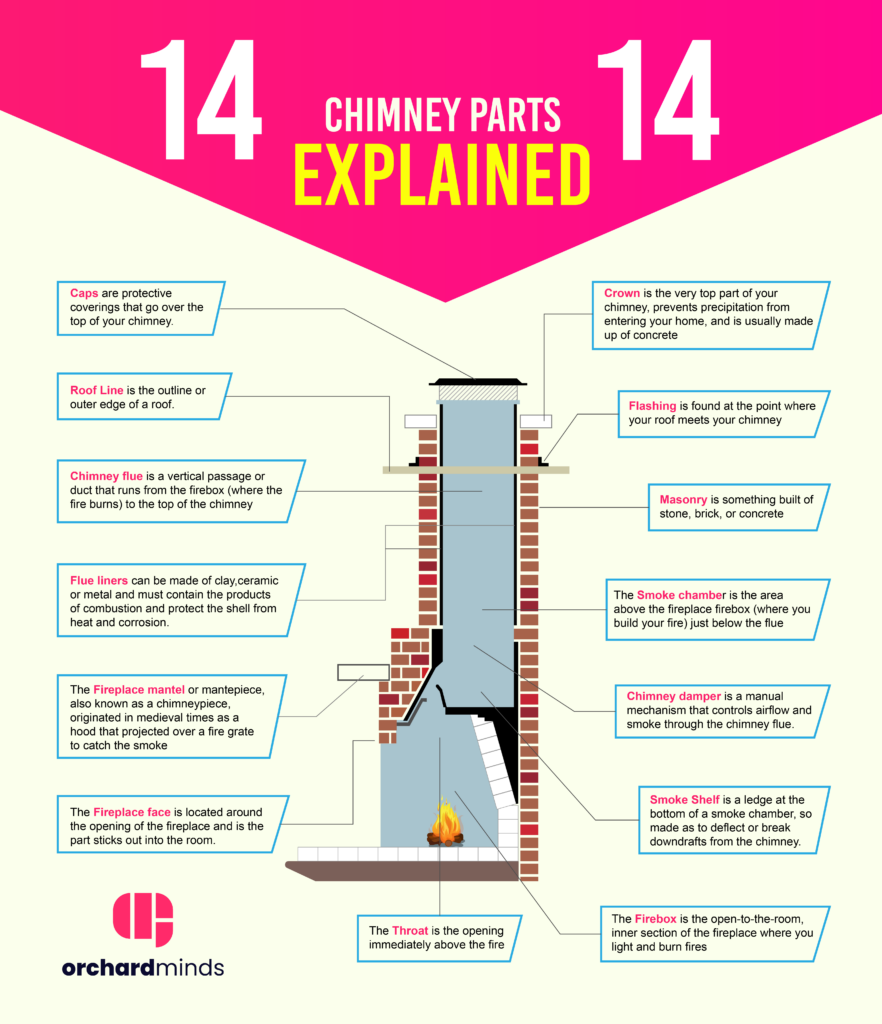
Key Takeaways:
By the end of this article, you will have gained insights into:
- The internal components of a chimney
- The external elements that make up a chimney
- The importance of regular chimney maintenance
Exterior Chimney Parts
1. Brick and Mortar:
The brick-and-mortar exterior of a chimney serves a dual purpose. Not only does it contribute to the chimney’s aesthetic appeal, but it also forms the core structural framework.
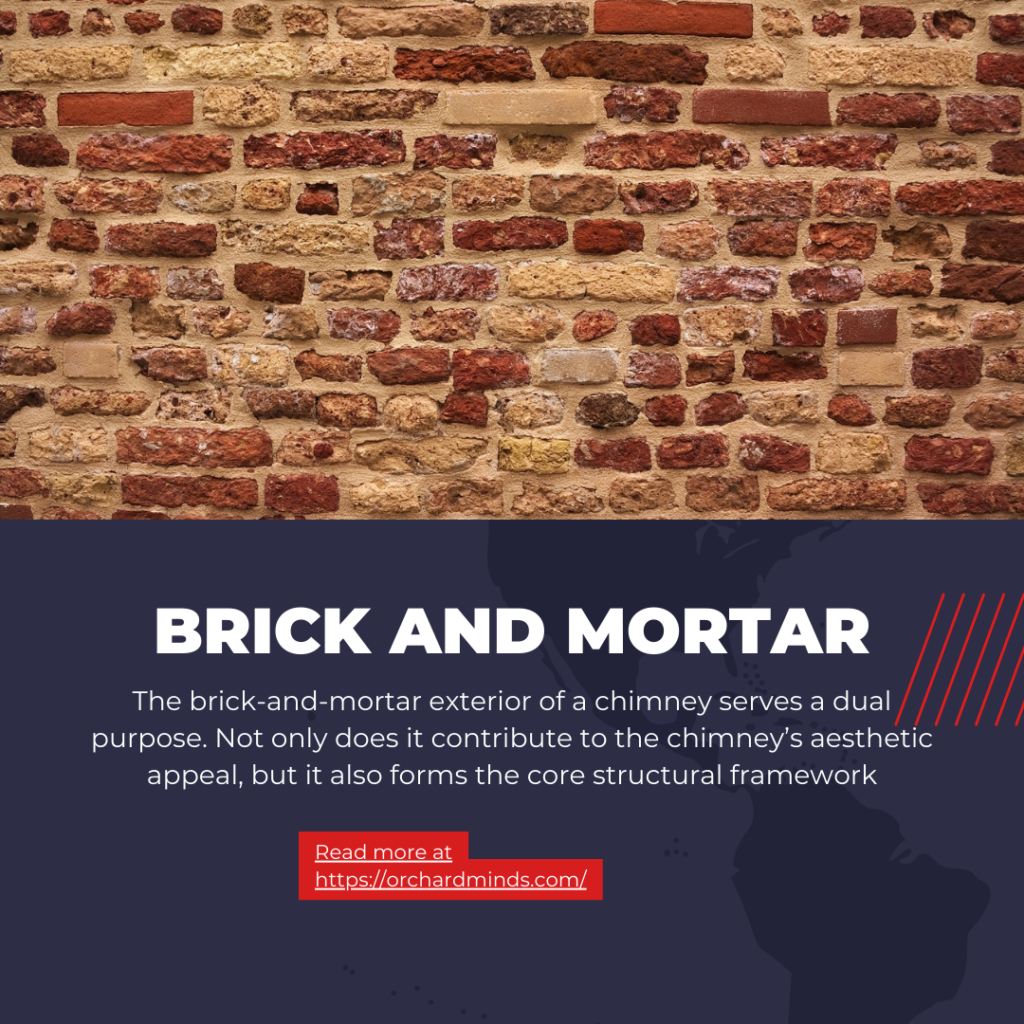
Bricks are meticulously stacked with mortar in between, creating a robust and heat-resistant structure that can withstand the extreme temperatures and thermal expansion generated by fires.
This durability is paramount for the chimney’s safe operation. However, over time, weather and exposure can take their toll. The mortar may deteriorate, and bricks can develop cracks. To ensure the longevity and safety of your chimney, it’s essential to conduct regular inspections and address any issues promptly.
This includes repointing, which involves reapplying mortar to damaged areas, thus extending the life of your chimney and preserving its visual charm.
2. Chimney Cap:
The chimney cap serves as the chimney’s first line of defense against the elements, providing multifaceted protection. It effectively prevents rainwater from entering the flue, a crucial function that safeguards the chimney structure and eliminates the potential for mold growth.
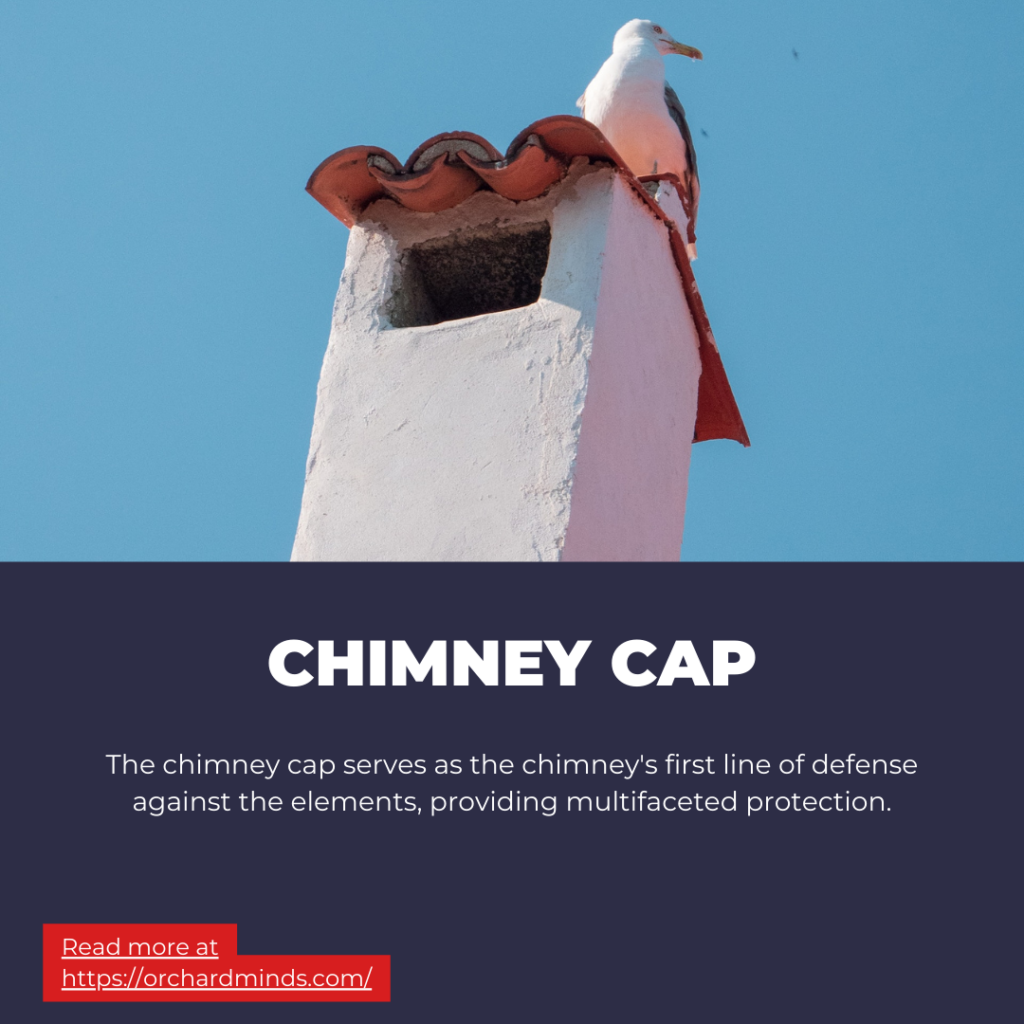
Additionally, chimney caps act as a wildlife barrier, deterring birds, squirrels, and other critters from nesting inside the chimney. This not only maintains the integrity of the chimney but also reduces the risk of flue blockages that can pose fire hazards.
Simultaneously, chimney caps facilitate proper ventilation by allowing gases and smoke to escape while skillfully blocking downdrafts, ensuring the safe and efficient operation of your chimney system.
3. Chimney Crown:
The chimney crown plays a crucial role in waterproofing and safeguarding the chimney from potential water damage. Usually constructed from concrete, it is designed to slope away from the flue, effectively shedding rainwater and preventing it from seeping into the chimney structure.
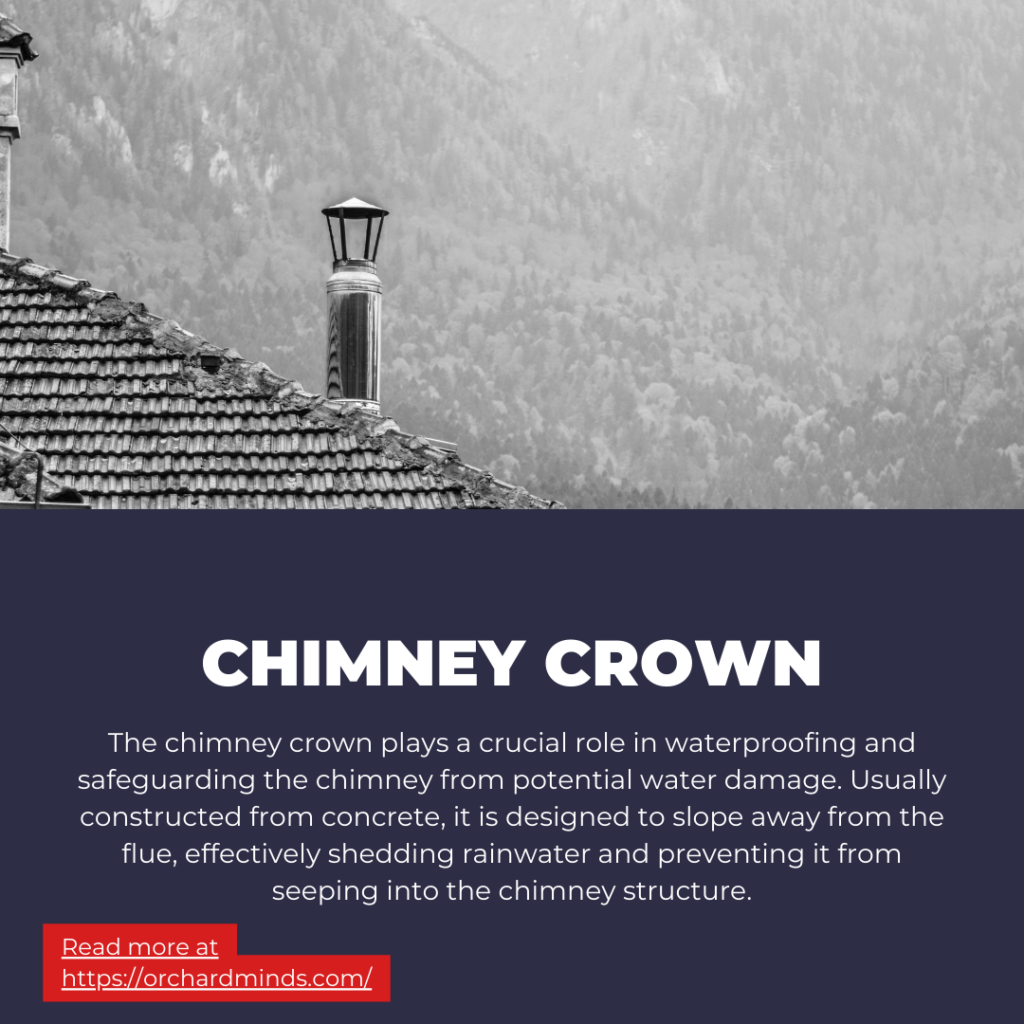
This proactive approach to waterproofing is vital as it prevents erosion of the masonry, which can lead to cracks, chipping (spalling), and ultimately compromise the chimney’s structural integrity.
To maintain the chimney’s protective capabilities, regular inspections of the chimney crown are essential. These inspections help identify any cracks or damage promptly. If issues are detected, repairs should be carried out without delay to avoid more extensive and costly structural problems down the line.
4. Flashing:
Flashing is a critical component that serves multiple essential functions in chimney maintenance. Comprising metal strips or sheets, it is strategically installed at the junction where the chimney meets the roof, with the primary objective of creating a watertight seal between these two structures.
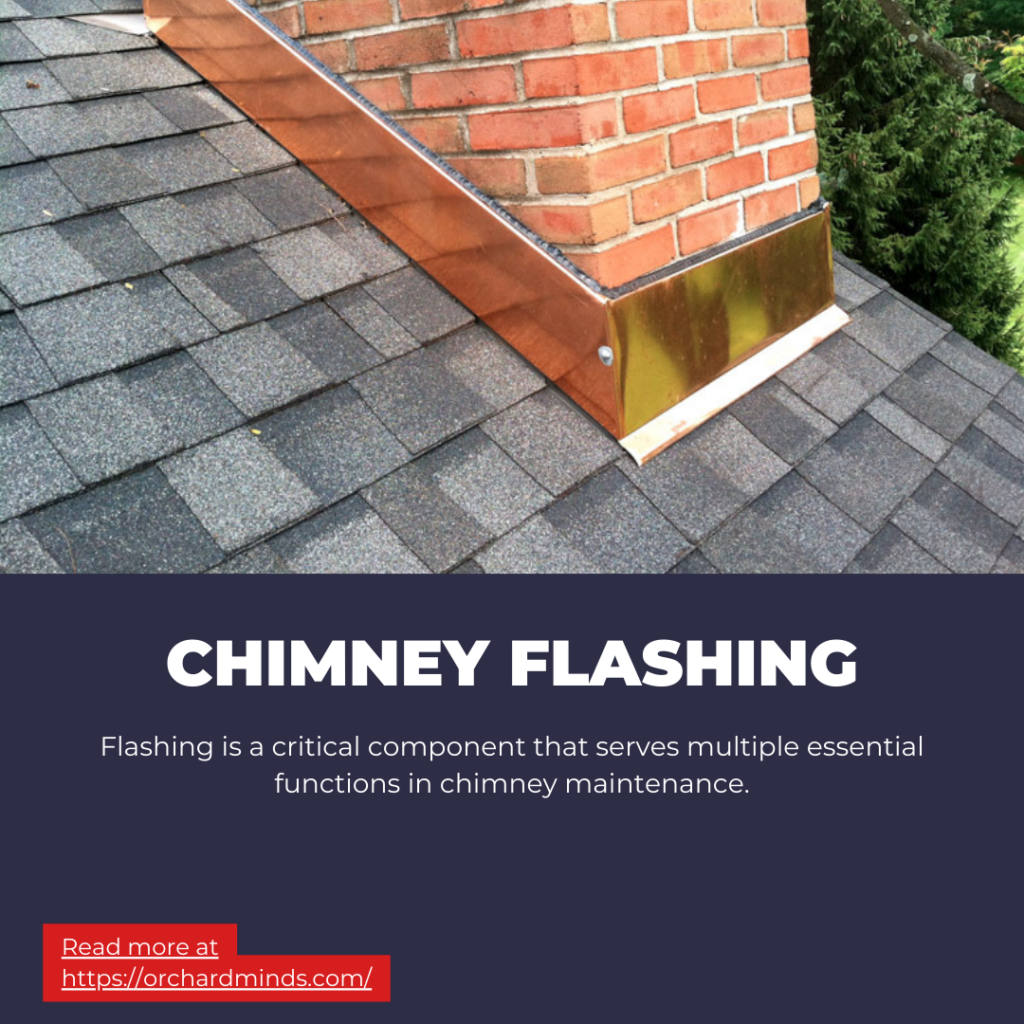
Its role extends to leak prevention, acting as a formidable barrier against water infiltration into the house through potential gaps in the roof and chimney joint, a concern that holds particular significance in regions prone to heavy rainfall.
The choice of materials for flashing is diverse, including options like galvanized steel, copper, or aluminum. Selecting the appropriate material and ensuring its proper installation are paramount to maximize its effectiveness in safeguarding your chimney and home from water-related issues.
5. Spark Arrestor
The spark arrestor, usually constructed from a fine mesh or screen, assumes a pivotal role in ensuring fire safety within the context of a chimney system. Its primary function is to prevent sparks, embers, and burning debris from escaping the chimney, thereby mitigating the risk of these elements igniting nearby flammable materials such as roof shingles.
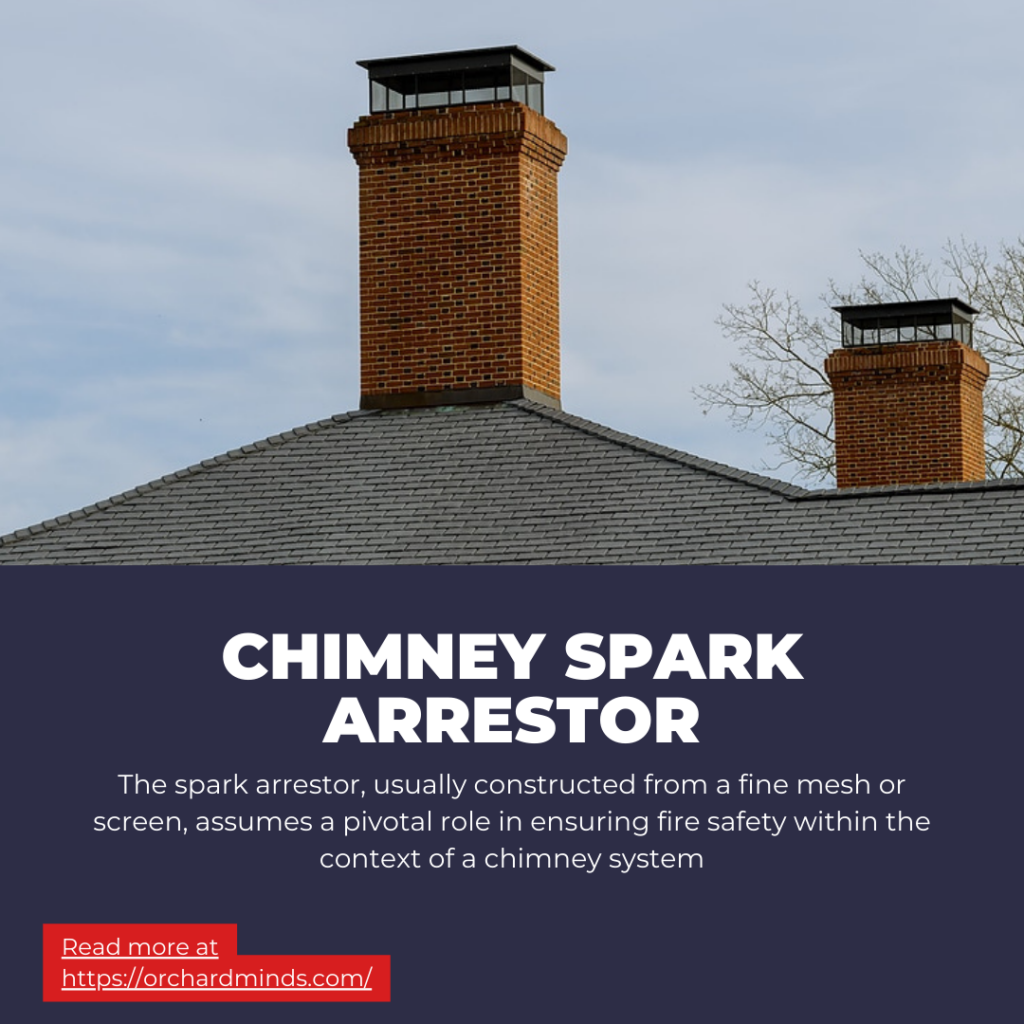
Moreover, it’s worth noting that in some areas, there are specific building codes or regulations in place that mandate the installation of spark arrestors as a precautionary measure to reduce the risk of chimney-related fires. To maintain its effectiveness, regular cleaning of the spark arrestor is essential.
Routine chimney inspections should encompass a thorough check and cleaning of the spark arrestor when necessary, ensuring it remains a reliable component in enhancing the safety of your chimney and home.
Interior Parts of a Chimney
1. Appliance Connector
The appliance connector is the crucial link between your fireplace or stove and the chimney. It serves as the passage through which smoke and gases generated by the fire are directed into the chimney, allowing them to rise and exit safely.
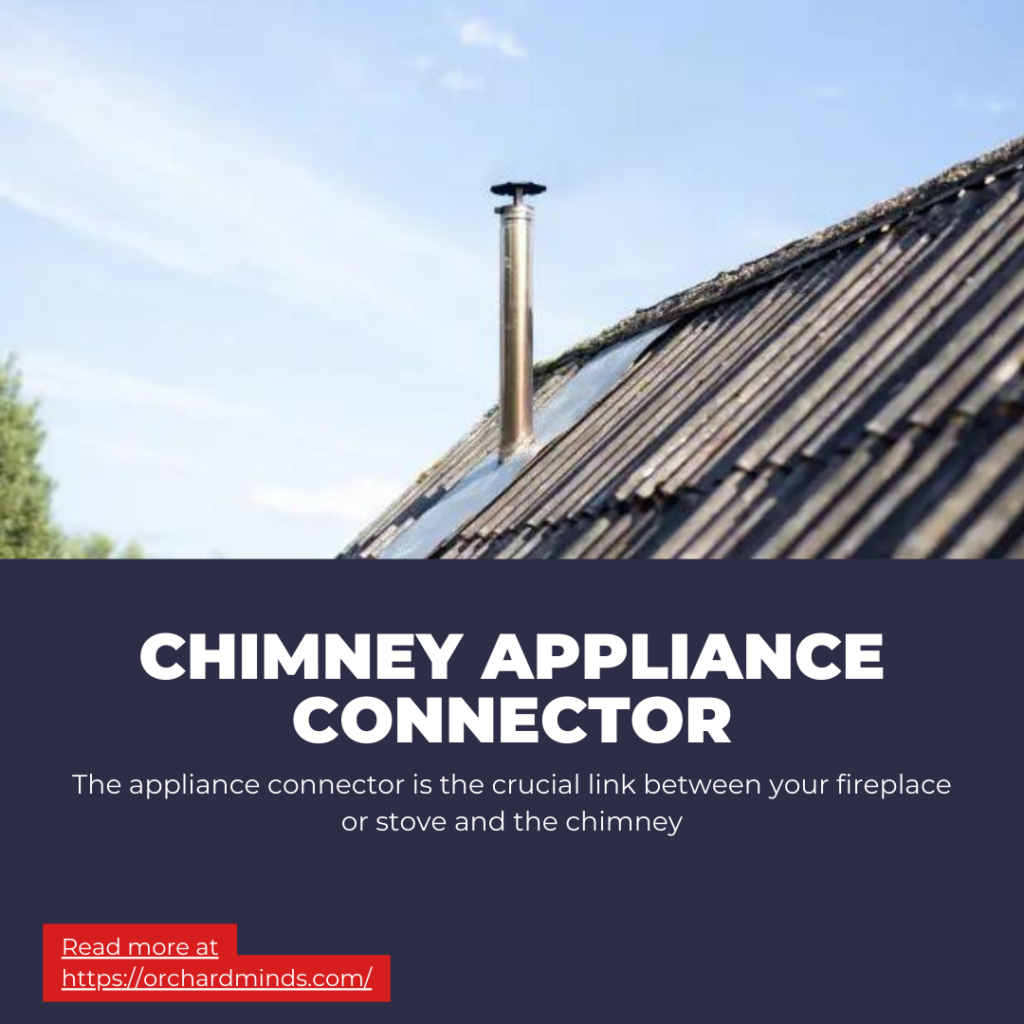
2. Ash Dump
Located near the bottom of the chimney, the ash dump serves as a convenient chamber for collecting ashes and debris resulting from burning wood or other fuels. This feature simplifies the process of ash disposal and helps maintain a clean fireplace or stove.
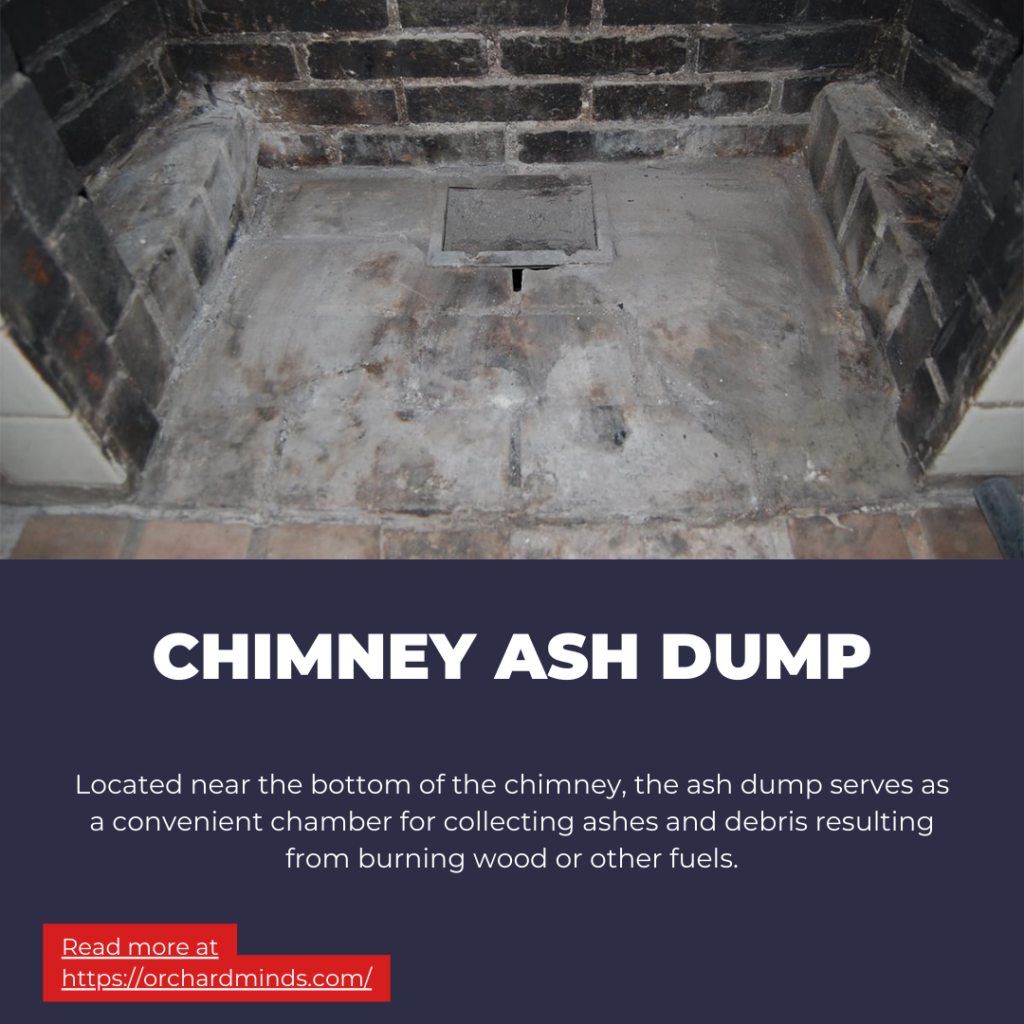
3. Ash Dump Door
The ash dump door is a protective component that covers the ash dump chamber. Its primary role is to prevent drafts from entering the chimney through this opening, which could interfere with the fireplace’s operation. Moreover, it contributes to safety by containing ashes within the chamber.
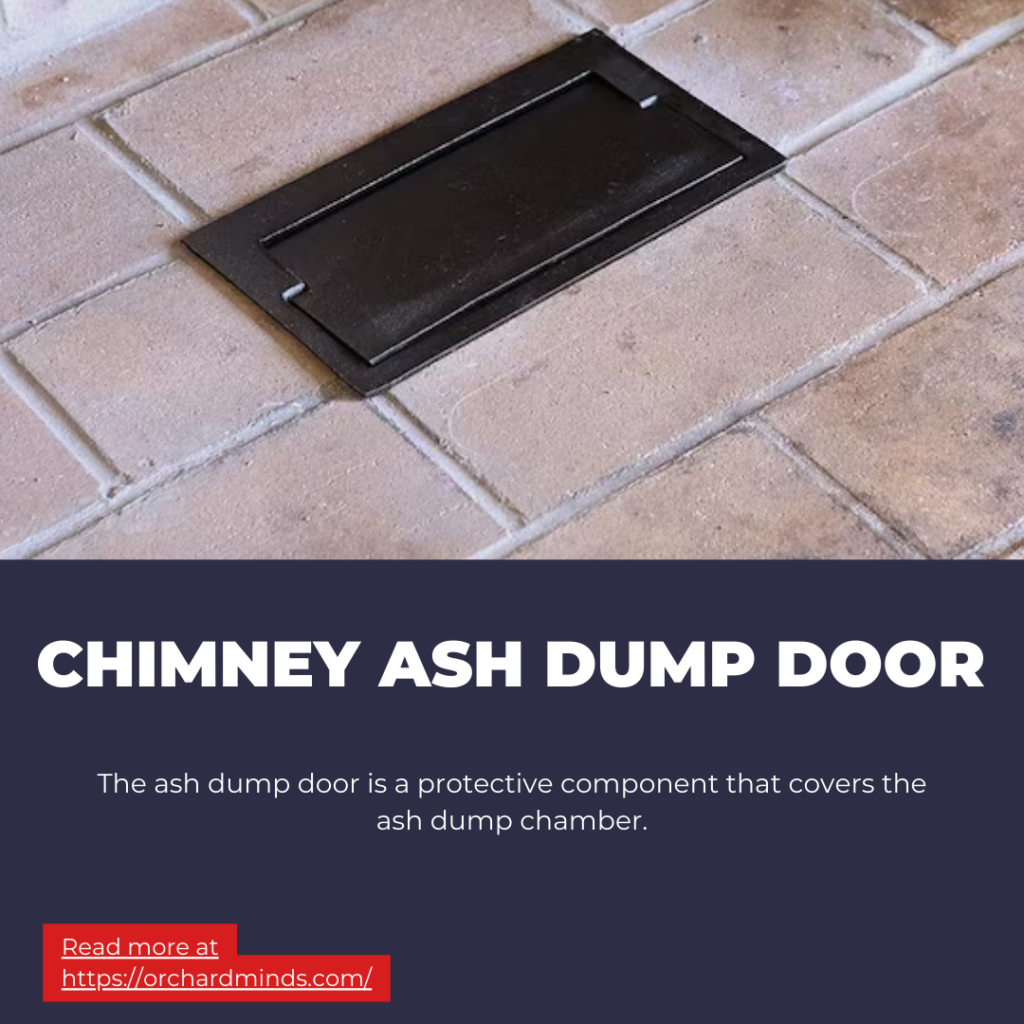
4. Clean-Out Opening
Positioned near the base of the chimney, the clean-out opening provides access for cleaning and maintenance.
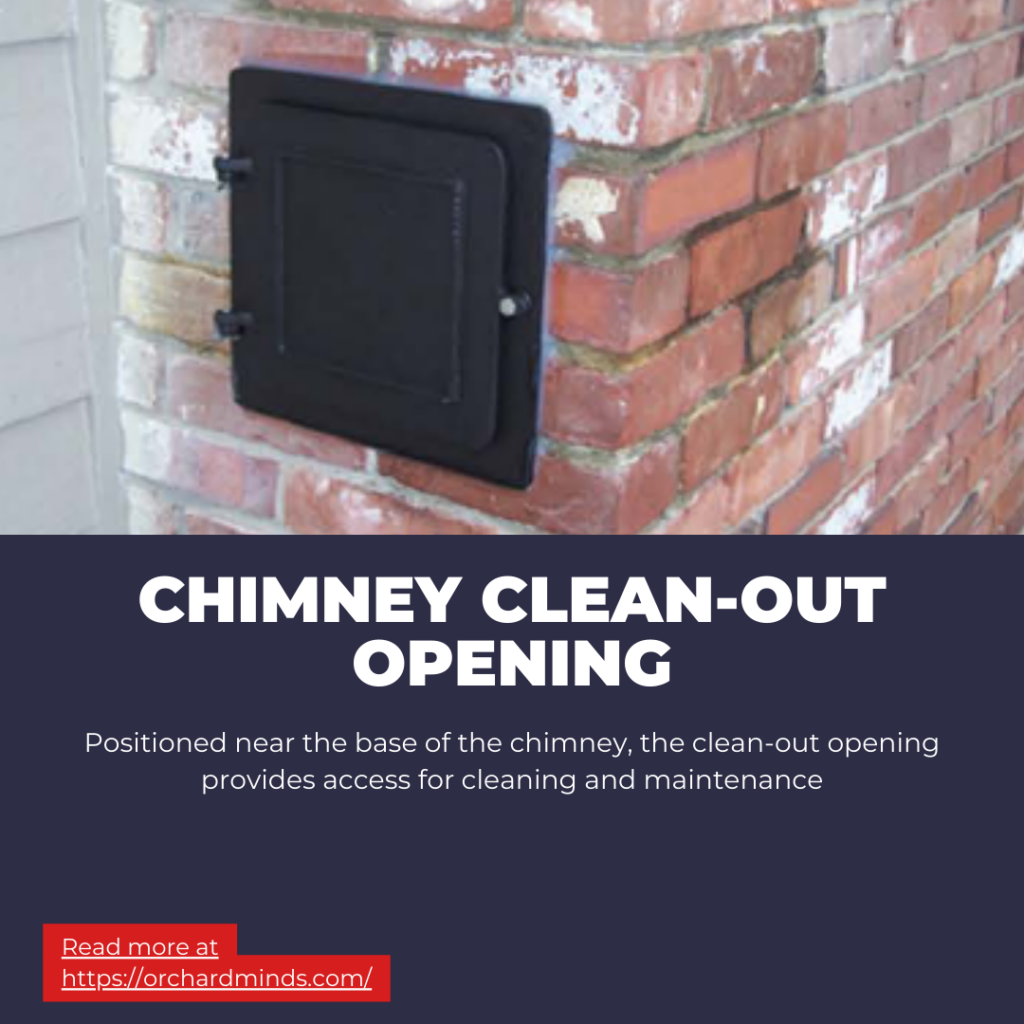
It allows homeowners or chimney professionals to remove accumulated soot, creosote, or debris, ensuring the proper functioning and safety of the chimney.
5. Firebox
The firebox is the heart of the fireplace or stove, where the fire burns.
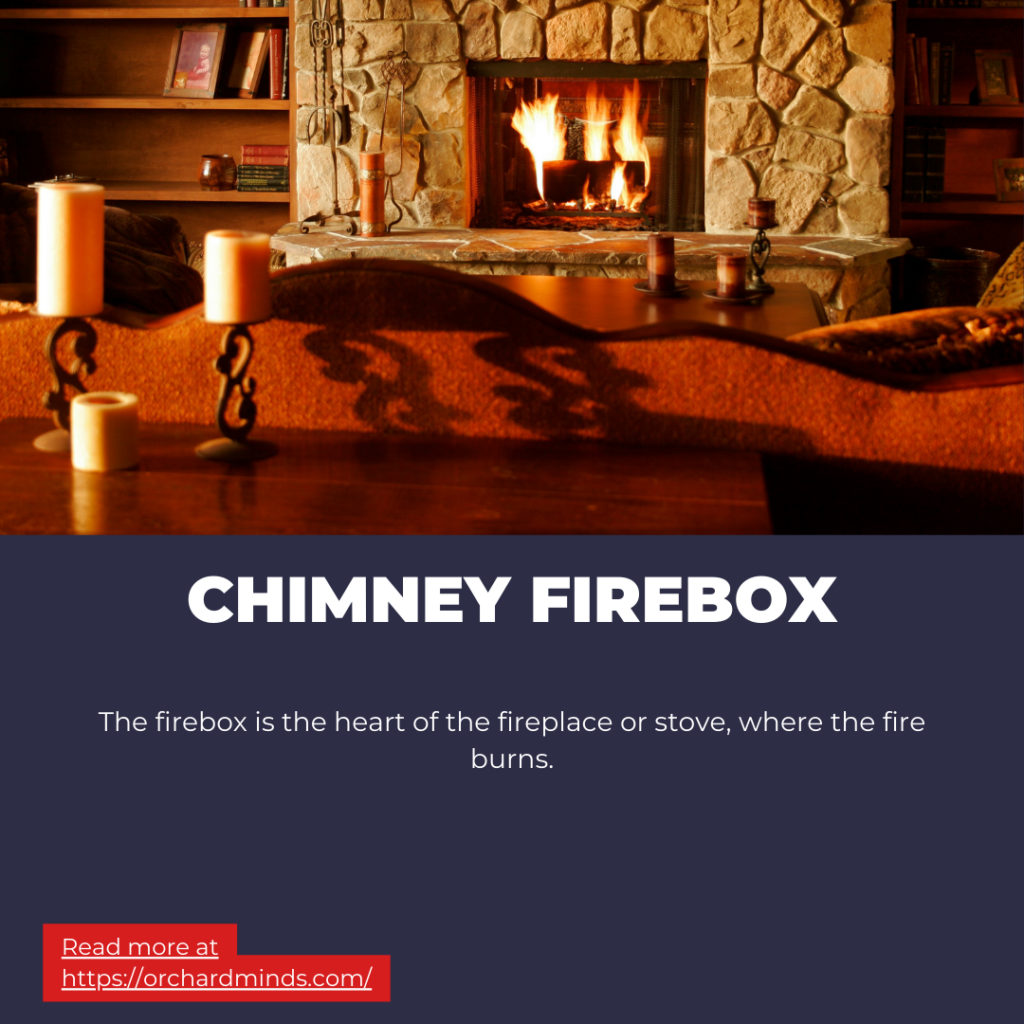
It is designed to withstand high temperatures and connects directly to the flue, allowing smoke and gases to enter the chimney. The firebox’s construction must be robust to ensure safety and efficiency.
6. Damper
The damper is a movable plate or valve located within the chimney. It plays a vital role in regulating airflow. When the fireplace is not in use, the damper can be closed to prevent heat loss and reduce cold drafts from entering the room. It can also be adjusted to control the intensity of the fire.
7. Flue and Flue Liner
The flue serves as the primary passageway for smoke and gases to exit the chimney. To enhance safety and efficiency, flues are often lined with fireproof materials, known as flue liners. These liners protect the chimney structure from heat and corrosion while promoting smoother airflow.
8. Smoke Chamber
The smoke chamber is the transition area between the firebox and the flue. Its design is critical for directing smoke and gases upwards into the flue. Proper construction of the smoke chamber helps prevent turbulence and ensures efficient smoke evacuation.
9. Smoke Shelf
Situated just above the firebox, the smoke shelf serves as a ledge that collects debris and prevents it from falling directly into the fire. This not only reduces the risk of chimney fires but also contributes to the overall safety and cleanliness of the fireplace or stove.
10. Wythe
The wythe is a layer of masonry that provides structural strength and insulation to the chimney. It adds to the chimney’s overall stability and contributes to its ability to withstand the stress of temperature fluctuations and external forces.
How to Take Care of Your Chimney
Taking care of your chimney is essential to ensure its safety and longevity. Start by scheduling regular chimney inspections by a qualified professional to identify and address any issues promptly.
Clean your chimney annually or as needed to remove creosote buildup and debris. Ensure the damper functions correctly and close it when the fireplace is not in use to prevent heat loss.
Use seasoned hardwoods to reduce creosote buildup and avoid burning trash or treated wood, which can release harmful chemicals. Install a chimney cap and maintain it to prevent water intrusion and blockage by animals or debris.
Finally, follow manufacturer guidelines for your specific appliance and consider regular maintenance as an investment in the safety and efficiency of your chimney system.
Summary: Different parts of a chimney you should know about
Understanding the different parts of a chimney is essential for homeowners who want to ensure the safety and functionality of their fireplace or stove.
From the inner workings that guide smoke and gases, to the protective outer components that shield the chimney from the elements, each part plays a vital role in keeping your home warm and secure.
Stay tuned for our upcoming article on chimney maintenance, where we’ll dive deeper into how to keep your chimney in top condition.
FAQs: What Are the Parts of a Chimney ?
How do I clean the flue of my chimney?
Cleaning the flue is a vital part of chimney maintenance. Cleaning the flue of your chimney typically involves using a chimney brush attached to flexible rods. Insert the brush into the flue from either the top or bottom and scrub the interior walls to remove soot and creosote buildup. Make sure to wear protective gear, like gloves and safety goggles, and cover nearby furniture to contain debris.
What’s the best way to clean the chimney damper?
To clean the damper, start by ensuring the fireplace is completely cool. Remove the damper assembly according to your chimney’s design (it may involve loosening screws or bolts). Clean any accumulated soot, debris, or rust from the damper using a wire brush or steel wool. Lubricate moving parts with a high-temperature lubricant before reassembling it.
How do I clean the chimney liner?
Cleaning the chimney liner depends on the type of liner you have. For metal liners, you can use a specially designed chimney brush and flexible rods to remove creosote and soot. For clay tile liners, it’s best to hire a professional chimney sweeper who can use appropriate cleaning tools to prevent damaging the fragile tiles.
What’s the recommended frequency for cleaning interior chimney parts?
It’s essential to have your chimney and its components inspected and cleaned annually, especially before the start of the heating season. However, the frequency may vary depending on usage. If you burn a lot of wood, it may need more frequent cleaning to prevent excessive buildup.
Are there any DIY cleaning solutions for chimney parts?
There are various DIY chimney cleaning solutions, like mixing baking soda and water into a paste to clean metal components. However, it’s generally recommended to consult a professional chimney sweeper for safety and thorough cleaning, as they have the appropriate tools and expertise.
What safety precautions should I take when cleaning chimney parts?
Always wear appropriate safety gear, including gloves and safety goggles, to protect yourself from soot and debris. Ensure the fireplace or stove is entirely cool before starting any cleaning. For more extensive cleaning or if you’re unsure, it’s best to hire a certified chimney sweep to ensure safety and effectiveness.

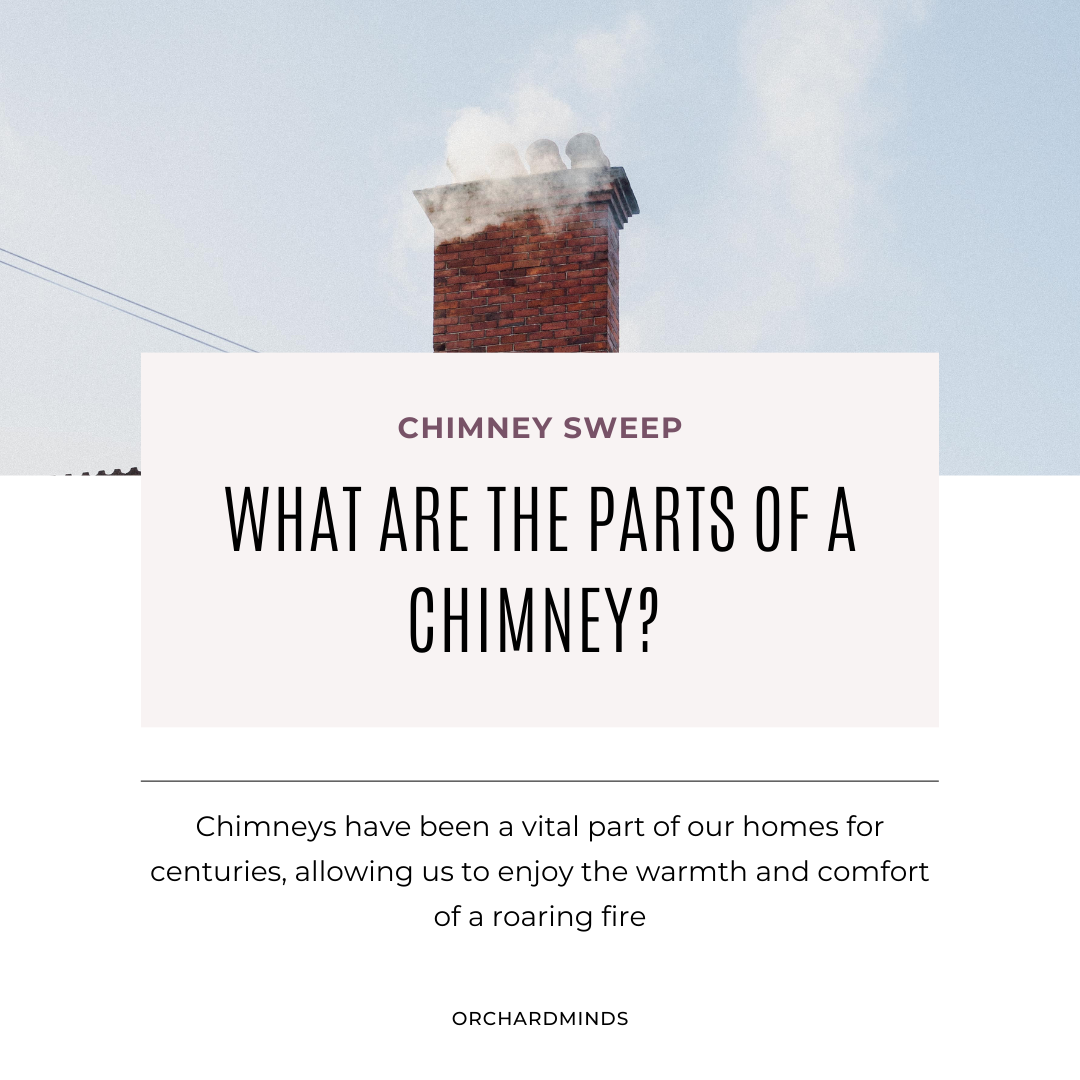
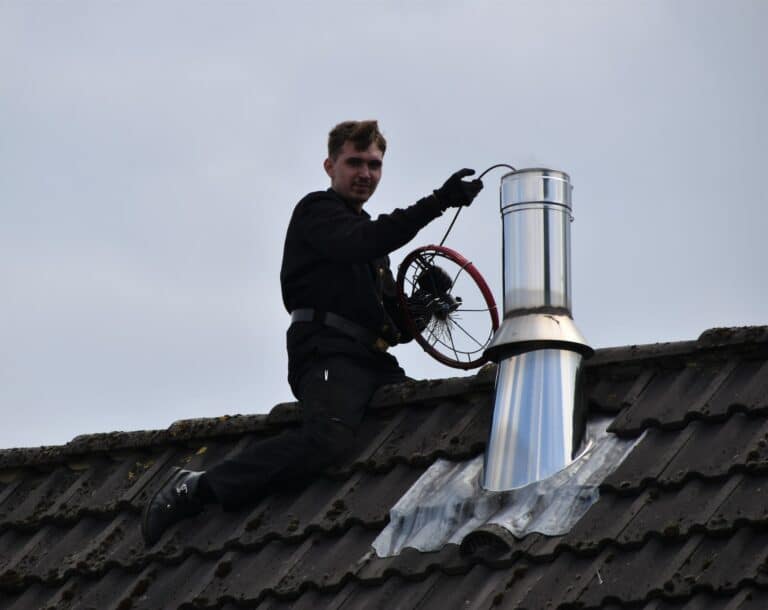
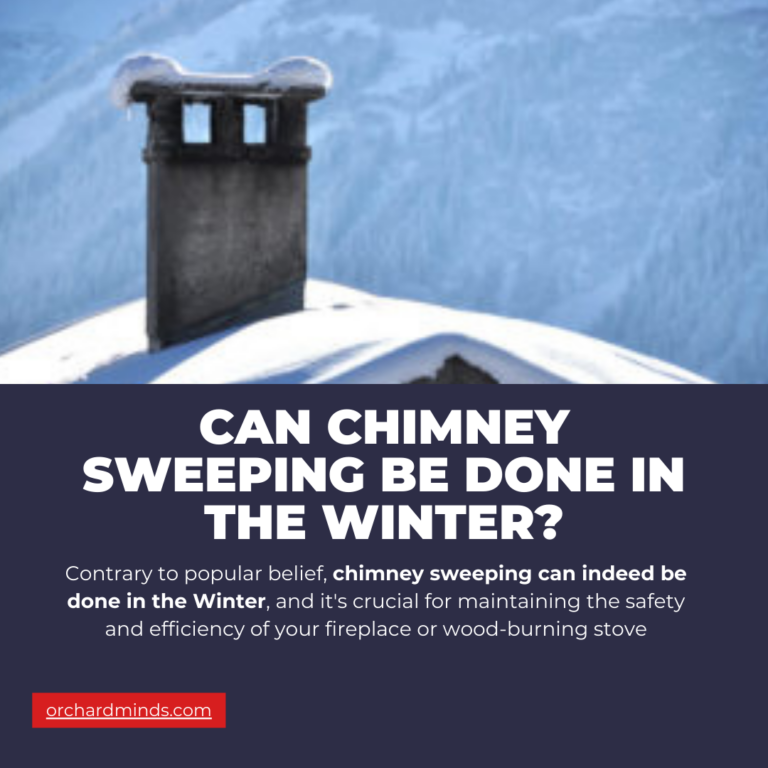
Leave a Comment